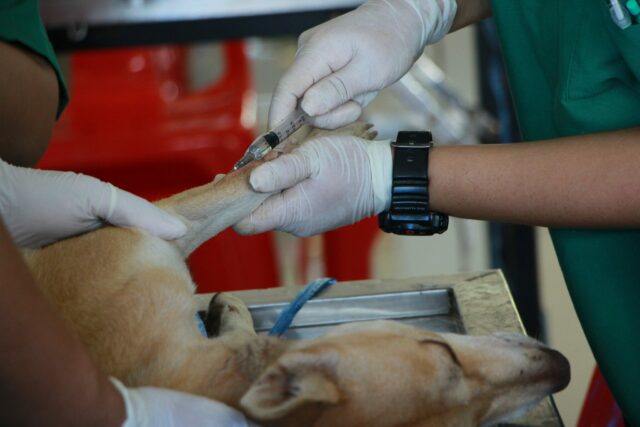Today I want to talk about an important topic! What Is Diabetes In Dogs and Signs Your Dog Has Diabetes?
This topic is important because early detection and treatment are required; otherwise, your dog will face life-threating complications. Take 10 minutes and read this to be able to prevent such complications from happening.
Like any other disease, we may face, or our pets suffer from, there is something abnormal happening to our bodies. When our dog’s body starts to deal with something new but unusual, then you are going to notice changes in the dogs because the body begins to show signs of the existence of abnormalities.
The same as in humans, diabetes is related to insulin and pancreas. In short, diabetes is a chronic condition that can affect animals, including dogs, cats, apes, pigs, and horses, as well as humans. Although there is no cure for diabetes, it can be managed very successfully by diet, exercise, and medically.

Table of Contents
What Is Canine Diabetes?
Before we start talking about every aspect of diabetes in dogs, we need to understand what is diabetes in dogs.
Diabetes mellitus (sugar diabetes) is a state of an abnormal concentration of glucose (sugar) in your dog’s blood. When the dog’s body fails to produce enough insulin, it causes diabetes, by making a little amount of insulin or doesn’t produce insulin correctly or not at all.
Some people may ask, what is glucose and insulin? What is the relation between those two? And why all this is happening in the first place.
- Glucose (Sugar) is the essential fuel for the body’s cells. The body produces glucose when the food is digested. The body starts breaking down the nutrients into glucose to send to the body’s cells. Glucose is the primary source of energy for body cells.
- Insulin is the transporter. Insulin is responsible for delivering glucose to the cells in need, and it acts as a gatekeeper to allow glucose to enter the cells. An organ called the pancreas produces insulin.
So, if there is any problem in this “process,” we are going to face a challenge. This harmonious relation between insulin and glucose is an essential close relation, and any problem in it will cause problems.

Canine Diabetes Has Two Forms
1- Insulin-deficiency diabetes. This type of diabetes when the body fails to produce a sufficient amount of insulin needed. The problem here mainly is from the pancreas. It is either damaged or not releasing insulin at all. This type of diabetes is the common one in dogs, and dogs need daily insulin injections.
2- Insulin-resistance diabetes. The problem here is the body not utilizing the insulin as it should. So, the cells here are not responding to the signals from insulin, which affects it negatively, and cells stop receiving glucose at it should. This form of diabetes can mainly occur in older, obese dogs.
Whether type one or type two of diabetes causes this problem, cells will start to signal this problem one way or another.
Cells will begin to show “starvation” for its “food.” As we mentioned before, cells need their fuel glucose to be able to do its job; the body starts to react to this problem and begin to break down its own fat and protein to use it as an alternative to glucose.
Logically, cells are not using glucose as the primary fuel, and therefore, the sugar in the blood rise to the level that starts to damage organs. Like anything in our life, when you break the balance in anything, it will cause problems. In this case, glucose begins to act as poison inside the body, causing abnormality in the chemistry of the blood. The problem can lead to Multi-Organ Damage. This often includes essential organs such as Kidney, heart, and eyes.

What are the symptoms of diabetes in dogs?
The symptoms of diabetes in dogs will start early, but as a dog owner, you need to pay attention to these symptoms and figure it out before it is late. The symptoms of diabetes in dogs can be noticed fast if you know your dog’s habit very well.
- Excessive thirst. When you notice your dog drink too much water or more than usual, and your dog may empty the water bowl so often, then it is a symptom your dog may have diabetes.
- Increased urination. This one may be tricky because some dogs would ask you to go outside frequently to play. However, if you notice it is about going out to urinate, then there is your symptom. Also, you may see your dog urinate inside the house accidentally. This is a normal response from the body to get rid of the extra glucose in the body through the Kidney.
- Weight loss. Unexplained losing weight despite your dog eating reasonable portions. This is because your dog’s body isn’t functioning normally, and it is not converting nutrients from its food.
- Increased appetite. Again this is another normal response from the body. Cells aren’t getting enough glucose or nothing at all, which causes a state of starvation. These cells start to send signals to the brain that they are “hungry,” so your dog starts to ask or eat more food.
Signs your dog has diabetes may vary, but there are some advanced signs. In more advanced cases of diabetes, the body starts to show more obvious signs and can include:
- Lack of energy
- Loss of appetite
- Depressed attitude
- Vomiting
The same as in humans, uncontrolled diabetes can lead to life-threatening conditions. Early detection for proper and early treatment is crucial. The effects of diabetes on the dog’s health can include many organs with dangerous complications. These complications of diabetes in dogs include:
- Seizures
- Kidney failure
- Enlarged Liver
- Cataracts which may lead to blindness
- Ketoacidosis: This is a life-threating condition. It is an acute problem accompanied by rapid breathing, lethargy, vomiting, dehydration, and/or sweet-smelling breath. Ketoacidosis can be triggered by different factors that cause stress, such as stress, surgery, infection, fasting, or underlying disease. Fortunately, there is a testing stick that can detect ketone bodies in the urine, which can be a way to prevent this condition from happening. So, all dog owners with diabetic dogs should keep this testing stick in their homes and do regular tests if possible.
After reading about signs your dog has diabetes and the complications of diabetes in dogs in case of uncontrolled diabetes, it is time to know what can make a dog at risk for diabetes?

Risk factors of diabetes in dogs
Some risk factors may cause diabetes in your dog.
- Age. Diabetes can occur at any age. However, older dogs are at more risk than younger dogs. Most of the cases of diabetes in dogs are diagnosed in middle-aged to senior dogs.
- Gender. Females are more at risk of having diabetes. It is twice as likely for males to have diabetes.
- Chronic pancreatitis. Chronic or repeated acute pancreatitis (inflammation of the pancreas) can eventually cause enough damage to it, resulting in diabetes.
- Obesity. Obesity is a significant reason for insulin resistance in the body as well as a reason to cause pancreatitis.
- Steroid medications. These can cause diabetes when used long-term.
- Cushing’s disease. The body overproduces steroids, which also can cause diabetes.
- Other health conditions. Some other diseases or conditions could cause diabetes, such as autoimmune disorders, and viral infections are also thought to trigger diabetes.
- Genetics. A 2003 study found that overall, mixed breeds and pure breeds share the same risks to diabetes. Also, genetics can play a role in either increased or reduced risk. Among pure breeds, there are some with low risk and others with higher risk. Some that may be at higher risk include Pugs, Dachshunds, Poodles, Bichons Frises, Miniature Schnauzers, Puli, Samoyeds, Fox Terriers, Cairn Terriers, Keeshonds, Australian Terriers, and Beagles.

Diagnosis of diabetes in dogs
Your veterinarian will perform simple tests to check for diabetes, including testing for excessive glucose (sugar) in the blood and urine. Blood tests can also show other indications of diabetes, such as high liver enzymes and electrolyte imbalances.
Diagnose diabetes in the early stage is crucial because we can prevent our dogs from having some serious complications which could threaten their life.
Treatment of diabetes in dogs
- Diet. Your veterinarian will start by recommending the best suitable type of diet for your diabetic dog. Usually, this will include some good-quality protein, fibers, and complex carbohydrates that will help to maintain a slow absorption of glucose. Your veterinarian may also recommend a low-fat diet.
- Exercise. Diabetic dogs must maintain a moderate but consistent exercise routine. To help avoid sudden drops in glucose levels or even sudden spikes in glucose levels.
- Insulin Injections. Most of the diabetic dogs may require daily shots of insulin under the skin. As a diabetic dog owner, you need to learn to do that.
Managing and Monitoring your dog’s diabetes
Canine diabetes is usually is easy to be successfully managed without any complication. In some cases, it can be challenging.
Managing your dog’s diabetes is extremely important. You would monitor your dog’s blood glucose and giving it daily injections. Without a doubt, you will be the primary role in managing your dog’s overall health.
Your vet will also help you to determine the best management plan for your dog. At the start of treatment, you may have frequent visits to the clinic for testing and medication adjustments. Still, once your vet determines the right combination of medication, dosage, diet, and home monitoring plan, you will then start to take care of your dog at home.
Remember, your dog is your friend and your family. So, make sure to take care of its health and make your dog happy. Taking care of its overall health, providing it with good healthy food, natural remedies, supplements, and toys is crucial to have a beautiful life together.

Sources:
- American Veterinary Medical Association (AVMA)
- PetMD
- Merck Veterinary Manual
- Adelaide Vet
- VCA Animal Hospitals
- American College of Veterinary Internal Medicine
So finally, I hope you found this article useful and informative. Let me know your answer. What do you think? Do you have more information about What Is Diabetes In Dogs – Signs Your Dog Has Diabetes? Write them down below.
If you have any other questions or different opinions about it, leave a comment below.
Today’s Quote:
“If aliens saw us walking our dogs and picking up their poop, who would they think is in charge?” –Author Unknown
You’ll Also Love These Posts:
Studies have shown if you like this blog article — you will also love the following posts.


Hi Doc
Thanks for sharing this. I had a pet who had diabetes which required insulin and another which obtained diabetes but we caught it too late. Looking back, all the signs were there – I was just not well informed enough to notice it in time. Thanks so much for sharing this as it is something I will know for the future. A couple of questions from my side – this article is particular to dogs. Would the exact same apply to cats or are there other things that I would need to look out for?
Also you mention that females are more at risk of having diabetes but it is twice as likely for males to have diabetes. I would expect those to be more at risk to convert into those who have. Why does it change between the genders?
Hello Tasneem,
Diabetes can show almost the same signs in any living being such as cats and dogs as well as humans. However, it is important to read about it to understand it fully and understand how to manage their diet. Females are at higher risk due to many things the most important risk factor pregnancy and changes in hormones. I will make sure to write more details about this topic in the near future.
Fascinating read, you don’t really think too much on the surface regarding animals and conditions such as diabetes. How prominent do you think diabetes is amongst canines?
I have been worried lately that my mum’s dog (springer spaniel) possibly had something akin to diabetes, but after reading the symptoms and behaviours, I’m confident it’s not that at all. We’ve also been treating him for fleas lately which is never fun!
I thought it was interesting that you mentioned studies showed that pure and mixed breads share the same or similar risk to diabetes.
I also think as primary carers to our canine pets, we are responsible not just for thier physical health, but also thier mental health too.
Hello Mike,
That is the power of learning new information that related to our fluffy friends. It is important to know and understand some common diseases to be able to help our fluffy friends and keep them happy. diabetes is treatable but sadly not curable. However, we can manage it good enough to avoid unnecessary complications.
I am happy you found this article helpful and informative.
Very educational post, an eye opener at that. Unfortunately i’ve never owned a dog and I had no idea that pets suffer from diabetes as well. Nonetheless, pets need to be taken good care of just like we do our own children and that’s when you’ll be able to detect if your pet is not well, by picking up certain things about them. Then it will make sense to take them to a vet for examination. Diabetes, others is a serious condition even for us humans. Learning more about these things, helps in detecting the symptoms early and addressing them accordingly before any major damage can occur, as you’ve stated. Your article has said it all. Very informative. knowledge is power. Looking forward to learning more in your up coming articles going forward. Thanks for sharing.
Hello Maggie,
Thank you for your kind words. I agree with you, knowledge is power. Knowing such information is needed to prevent further damage these diseases may cause if we don’t control them fast. I am glad it was informative and helpful for you.
Hi, Dr.Alkhawaldeh,
First of all, I must say I’m really impressed by the professionalism portrayed in your article. I can clearly see that you spent time putting this together for an easy read. Your article is really informative and I even learned a few new things. The first time I heard about canine diabetes was a few years ago. I never imagined that animals, in this case dogs, could suffer the same diseases humans do.
I really liked the fact that you explained everything in a simple manner, but detailed nonetheless. Any person can fully comprehend what you’re saying. There is so much useful information any dog owner/dog lover should know.
I completely agree with you. Dogs are a part of the family and need to be taken care of. We need to supervise their nutrition and physical activity. After all, they only have us.
I was going to ask if you had any veterinarian training, but then I saw your title and dismissed the idea. Congratulations on your article. Thanks for sharing.
Hello Enrique,
Thank you for your kind words. It is important for us to understand and know these common problems people may miss due to a lack of information. It is our duty, after all, to protect and help dogs to avoid dangerous diseases and find the best treatment for them and prevent complications. Also, it is important to know how diseases show us signs to be able to treat it fast. Pets are part of our families so it is a must to keep them happy and healthy.
Doc,
Over the years I’ve had one spouse and several cats and dogs that had diabetes. One dog got it along with Cushings, as you mentioned, and two ended up blind. Diabetes is a tragic disease, and this article points out the symptoms very well.
If my dog should show the symptoms, how do I catch it early enough to avoid the worst consequences? Also, is there a way to avoid diabetes altogether by controlling diet or anything else?
Your answers would be greatly appreciated.
Steve
Hello Steve,
It is difficult to see our dogs with diabetes and affecting their lives. I am sorry to hear they ended up blind. Regarding your first question, as I mentioned, the first signs are thirst and going out to pee a lot. When you notice these 2 signs or symptoms you should take your dog to your vet for screening. After all, this considered abnormal. A balanced diet and good daily exercise should be enough to keep our dog healthy and happy. There is nothing in specific to prevent from happening but it is good to have a balanced life to reduce the risk.